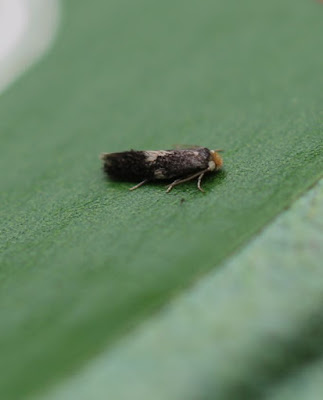22 June 2017
22 June 2017 – Collars and Earmuffs
 |
| Red-necked Footman (Atolmis rubricollis) |
The number of moths in the trap has been increasing every week and we are also starting to get a wider variety of species. I had to take care of Monday’s trap alone for the first time. I will admit that it was scary, not the task in particular, but seemingly dozens of crane flies and giant beetles that had an attraction towards my face. There were some recognizable moths among the group but there were also some new ones as well!
The Red-necked Footman (Atolmis rubricollis) was one of the moths caught in our trap. The moth caught my eye with its quintessential red collar so I immediately took photographs. It really stands out against the black body of the moth. Its name Atolmis means ‘lack of courage’, which describes the larvae’s habit of hiding in tree bark during the day; rubricollis means ‘red neck’ which fits perfectly with the moth.
 |
| Lichen on apple tree |
Quite rare and local, Atolmis rubricollis can also be sometimes seen during the day as well as the night. The larvae feed on lichen which is present in our quarry.
 |
| (Ectodemia albifasciella) |
Another moth caught was Ectoedemia albifasciella. One other Ectoedemia species was found in July 2013 – Ectoedemia decentella. As the earlier blog post describes, this moth looks rather charming with the two white spots resembling earmuffs. It also has an orange head which looks kind of like a hat.
 |
| Petiole of Oak leaf |
Ectoedemia
means ‘an outside swelling’ which reflects the eating habits of the larvae. When the larva feed on the leaf petiole, the part connecting the leaf to a branch (see above), it creates a growth. The second part of the binomial is albifasciella meaning the ‘white band’ details of the pattern on the fore-wing of the moth. The larvae feed mainly on oak (Quercus).
 |
| (Caloptilia sp.) |
The third moth identified is either a Caloptilia robustella or a Caloptilia alchimiella. The moths are difficult to distinguish by just visual appearance so dissection would be necessary. Since we do not dissect we can only narrow it down to one of the two. At first, I thought it was a Caloptilia stigmatella which we have seen once before, but the triangle pattern on Caloptilia stigmatella is placed slightly differently and it is more hooked. Although we can’t be certain which species of moth it is, neither Caloptilia robustella nor Caloptilia alchimiella have been seen at Shandy Hall before so a new species can confidently be claimed.
Both species of moth lay eggs on oak and the larvae subsequently feed on the leaves after hatching.
All three species are new to Shandy Hall, which makes our count 414!
Post : Walter Chen [UPenn intern]
Recent Moths
- 25 July 2023 – Collective Noun for Hawkmoths
- MOTH LIST to August 2023 with links
- 28 July 2023 – TRIPLE New Species Alert!
- 18 July 2023 – A Golden…Plusia!
- 13 July 2023 – Arts and Sciences
- 10 July 2023 – Rise of the Yellow Underwings
- 4 July 2023 – Cold-weather Catch
- 4 July 2023 – Mother of Pearl, an Inspiration to Science
- 28 June 2023 – Buff-tipped Marble
- 23 June 2023 – Moth or Butterfly?
- 20 June 2023 – Bee, Straw, Emerald and a Ghost
- 17 June 2023 – Old and New






